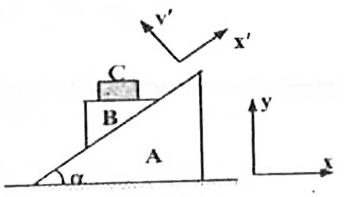In the adjoining figure a wedge is fixed to an elevator moving upwards with an acceleration a. A block of mass m is placed over the wedge.Find the acceleration of the block with respect to wedge. Neglect friction

Since, acceleration of block w.r.t. wedge ( an accelerating or non-inertial frame of reference) is to be find out.
FBD of block w.r.t . Wedge is shown in fig.

The acceleration would had been g sinθ (down the plane) if the lift were stationery or when only weight (i.e.,mg) acts downwards.
Here, downward force is m(g+a)
∴ Acceleration of the block ( of course w.r.t. wedge) will be (g+a) sinθ down the plane.
Topper's Solved these Questions
- LAWS OF MOTIONBook:DC PANDEYChapter:LAWS OF MOTIONExercise:Check point 5.1
Explore 20 Videos
- LAWS OF MOTIONBook:DC PANDEYChapter:LAWS OF MOTIONExercise:Check point 5.2
Explore 15 Videos
- LAWS OF MOTIONBook:DC PANDEYChapter:LAWS OF MOTIONExercise:Subjective Question
Explore 27 Videos
- KINEMATICS 1Book:DC PANDEYChapter:KINEMATICS 1Exercise:INTEGER_TYPE
Explore 15 Videos
- LAWS OF THERMODYNAMICSBook:DC PANDEYChapter:LAWS OF THERMODYNAMICSExercise:Level 2 Subjective
Explore 18 Videos
Similar Questions
In the shown figure, the wedge A is fixed to the ground. The prism B of mass M and the block C of mass m is placed as shown. Find the acceleration of the block C w.r.t. B when the system is set free. Neglect any friction.

View SolutionIn the arrangement shown in the fig. the block of mass m lies on the wedge. Wedge is moving with acceleration a = 5 m/sec . Find the wedge acceleration of the block with respect to wedge.
View Solution
Knowledge Check
A lift is moving upwards as shown in figure in figure A block of mass m s placed on a wedge inside the left and it is statioary with to lift
Net force acting on m is
 AzeroBma (upwards)CmgsinθDma (downwards)
AzeroBma (upwards)CmgsinθDma (downwards)A block of mass m=5kg is placed on the wedge of mass M=32kg as shown in the figure. Find the acceleration of wedge with respect to ground. (Neglect any type of friction. Spring and pulley are ideal)
 A12m/s2B34m/s2C43m/s2D35m/s2
A12m/s2B34m/s2C43m/s2D35m/s2In the arrangement shown in figure wedge of mass M moves towards left with an acceleration a. All surfaces are smooth. The acceleration of mass m relative to wedge is
 Aa/2B2MamC2(M+m)amD(M+m)am
Aa/2B2MamC2(M+m)amD(M+m)am
In the arrangement shown in the fig. the block of mass m lies on the wedge. Wedge is moving with acceleration a = 5 m/sec Find the wedge acceleration of the block with respect to wedge.
View SolutionA block of mass m is at rest over the rough surface of the fixed wedge.


View SolutionFigure shows a block A constrained to slide along the inclined plane of the wedge B shown. Block A is attached with a string which passes through three ideal pulleys and connected to the wedge B. If wedge is pulled toward right with an acceleration a, find
(a) the acceleration of the block with respect to wedge
(b) the acceleration of the block with respect to ground.

View SolutionA block of mass 1 kg is placed on a rough wedge which is fixed on an elevator going upward with acceleration 2ms−2. The block is a rest with respect to the wedge.

Select the correct alternative ( take g=10ms−2 )
View SolutionA block of mass m=5 kg is placed on the wedge of mass M=32 kg as shown in the figure. Find the acceleration of wedge with respect to ground. (Neglect any type of friction. String and pulley are ideal )

View Solution

